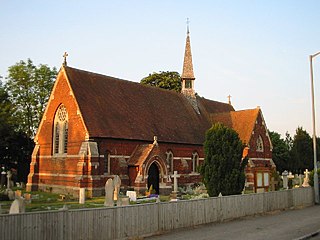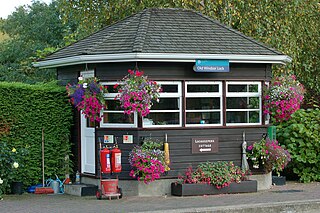
Maidenhead is a market town in the Royal Borough of Windsor and Maidenhead in the county of Berkshire, England, on the southwestern bank of the River Thames. In the 2021 Census, it had an estimated population of 70,374 and forms part of the border with southern Buckinghamshire. The town is situated 27 miles (43 km) west of Charing Cross, London and 13 miles (21 km) east-northeast of the county town of Reading. The town differs from the Parliamentary constituency of Maidenhead, which includes a number of outer suburbs and villages, including villages which form part of the Borough of Wokingham such as Twyford, Charvil, Remenham, Ruscombe and Wargrave.

The Royal Borough of Windsor and Maidenhead is a unitary authority area with royal borough status in Berkshire, England. The borough is named after its two largest towns of Maidenhead and Windsor. The borough also includes the towns of Ascot and Eton, plus numerous villages and surrounding rural areas. It is home to Windsor Castle, Eton College, Legoland Windsor and Ascot Racecourse. It is one of only four boroughs in England entitled to be prefixed royal, and the only one of them which is not a London borough.

Wraysbury is a village and civil parish in the Royal Borough of Windsor and Maidenhead in England. It is under the western approach path of London Heathrow Airport. It is located on the east bank of the River Thames, roughly midway between Windsor and Staines-upon-Thames, and 18 miles (29 km) west by south-west of London. Historically part of Buckinghamshire, Wraysbury was made part of the new non-metropolitan county of Berkshire in 1974, under the Local Government Act 1972. The Wraysbury Reservoir is located to the east, administratively wholly in the Spelthorne district of Surrey, although it was historically divided between Buckinghamshire and Middlesex.

Windsor is a historic town in the Royal Borough of Windsor and Maidenhead in Berkshire, England. It is the site of Windsor Castle, one of the official residences of the British monarch. The town is situated 21.8 miles (35.1 km) west of Charing Cross, central London, 5.8 miles (9.3 km) southeast of Maidenhead, and 15.8 miles (25.4 km) east of the modern county town of Reading. It is immediately south of the River Thames, which forms its boundary with its smaller, ancient twin town of Eton. The village of Old Windsor, just over 2 miles (3 km) to the south, predates what is now called Windsor by around 300 years. In the past, Windsor was formally referred to as New Windsor to distinguish the two.

Eton is a town in Berkshire, England, on the opposite bank of the River Thames to Windsor, connected to it by Windsor Bridge. The civil parish, which also includes the village of Eton Wick two miles west of the town, had a population of 4,692 at the 2011 Census. Within the boundaries of the historic county of Buckinghamshire, in 1974 it came under the administration of Berkshire following the Local Government Act 1972; since 1998 it has been part of the unitary authority of Windsor and Maidenhead. The town is best known as the location of Eton College.

Horton is a village and civil parish in Berkshire, England. It is between Windsor and Staines-upon-Thames.

Sutton Courtenay is a village and civil parish in the Vale of White Horse district of Oxfordshire, England. It is situated on the south bank of the River Thames 2 miles (3 km) south of Abingdon-on-Thames and 3 miles (5 km) northwest of Didcot. The 2021 census recorded the parish's population as 3,055, a rise from 2,421 in 2011.

Sonning is a village and civil parish in Berkshire, England, on the River Thames, east of Reading. The village was described by Jerome K. Jerome in his book Three Men in a Boat as "the most fairy-like little nook on the whole river".

Streatley is a village and civil parish on the River Thames in Berkshire, England. The village faces Goring-on-Thames. The two places share in their shops, services, leisure, sports and much of their transport. Across the river is Goring & Streatley railway station and the village cluster adjoins a lock and weir. The west of the village is a mixture of agriculture and woodland plus a golf course. The village has a riverside hotel. Much of Streatley is at steeply varying elevations, ranging from 51m AOD to 185m at Streatley Warren, a hilltop point on its western border forming the eastern end of the Berkshire Downs. This Area of Outstanding Natural Beauty is topped by the 87-mile The Ridgeway path, which crosses the Thames at Goring and Streatley Bridge.

Eton Wick is a village and former civil parish, now in the parish of Eton, in the Windsor and Maidenhead district, in Berkshire, England. Historically it was part of Buckinghamshire. Between the River Thames and the Jubilee River, the village is close to the towns of Windsor, Eton and Slough. The village has a long history, with evidence of habitation dating back over 5,500 years, including a Neolithic causewayed enclosure and a variety of later historical periods marked by significant agricultural and social development.

Old Windsor is a village and civil parish, in the Royal Borough of Windsor and Maidenhead, in Berkshire, England. It is bounded by the River Thames to the east and the Windsor Great Park to the west.

Cookham is a historic Thames-side village and civil parish on the north-eastern edge of Berkshire, England, 2.9 miles (5 km) north-north-east of Maidenhead and opposite the village of Bourne End. Cookham forms the southernmost and most rural part of the High Wycombe urban area. With adjoining Cookham Rise and Cookham Dean, it had a combined population of 5,779 at the 2011 Census. In 2011, The Daily Telegraph deemed Cookham Britain's second richest village.

Ditton Park, Ditton Manor House or Ditton Park House was the manor house and private feudal demesne of the lord of the Manor of Ditton, and refers today to the rebuilt building and smaller grounds towards the edge of the town of Slough in England. A key feature is its centuries-old moat which extends to most of the adjoining lawns and garden. Park areas extend to the north and west of the moat.

Bisham is a village and civil parish in the Royal Borough of Windsor and Maidenhead in Berkshire, England. The village is on the River Thames, around one mile (1.6 km) south of Marlow in the neighbouring county of Buckinghamshire, and around three miles (5 km) northwest of Maidenhead. At the 2011 Census, the population of the parish was 1,099, down from 1,149 at the 2001 Census. Bisham is home to one of Sport England's National Sports Centres.

Remenham is a village and civil parish on the Berkshire bank of the River Thames opposite Henley-on-Thames in southern England. It is particularly well known for the steep approach, known as Remenham Hill or White Hill, into Henley.

History of Staines-upon-Thames in Surrey, England, and historically in the county of Middlesex.
Pinkneys Green is a semi-rural village near the town of Maidenhead, Berkshire. It sits within the ancient parish of Cookham.

Old Windsor Lock is a lock on the River Thames in England on the right bank beside Old Windsor, Berkshire. The lock marks the downstream end of the New Cut, a meander cutoff built in 1822 by the Thames Navigation Commissioners which created Ham Island. The lock and a wider footbridge give access to the island. Two weirs are associated; the smaller adjoins and the larger is upstream. The lock is the ninth lowest of the forty-five on the river.

Datchet Bridge, also known as The Divided Bridge, was a road bridge which crossed the River Thames at Datchet from 1706 until it was demolished in 1848. It was situated on the reach between Old Windsor Lock and Romney Lock and linked Windsor on the Berkshire bank to Datchet on the Buckinghamshire side. The bridge replaced a ferry service which had operated at the site since at least the middle of the 13th century.

The Windsor Castle Act 1848 was an Act of Parliament enacted for the British royal family that reformed land use and rights around Windsor Castle, in Berkshire. The Act's main purpose was to create Home Park. All new roads and bridges were built by 1850. The result turned the former royal estate, which was known as Little Park, into the royal private estate of Home Park.























